Report: Analysis of Service Management and ITIL Framework
VerifiedAdded on 2023/03/17
|22
|4375
|31
Report
AI Summary
This report provides a comprehensive analysis of service management within an IT context, focusing on the ITIL framework. It begins with an introduction to ITSM and ITIL, outlining the ITIL core and its importance. The report then delves into governance and risk management, emphasizing their role in maintaining a healthy IT environment. Continual Service Improvement (CSI) is discussed, including its purpose, scope, objectives, and value to the business. Business Relationship Management (BRM) is examined, detailing its purpose, objectives, and key activities. The report also covers Service Level Management (SLM), Financial Management for IT Services, Business Case, Demand Management, Capacity Management, IT Service Continuity Management, Information Security Management, and Problem Management. It concludes with a discussion of the Seven Step Improvement Process, Critical Success Factors, and the Deming Cycle, providing a holistic view of service management practices. The report emphasizes the importance of each process in ensuring effective IT service delivery and customer satisfaction.

Running head: ANALYSIS OF THE SERVICE MANAGEMENT
Analysis of the Service Management
Name of the student:
Name of the university:
Author Note:
Analysis of the Service Management
Name of the student:
Name of the university:
Author Note:
Paraphrase This Document
Need a fresh take? Get an instant paraphrase of this document with our AI Paraphraser
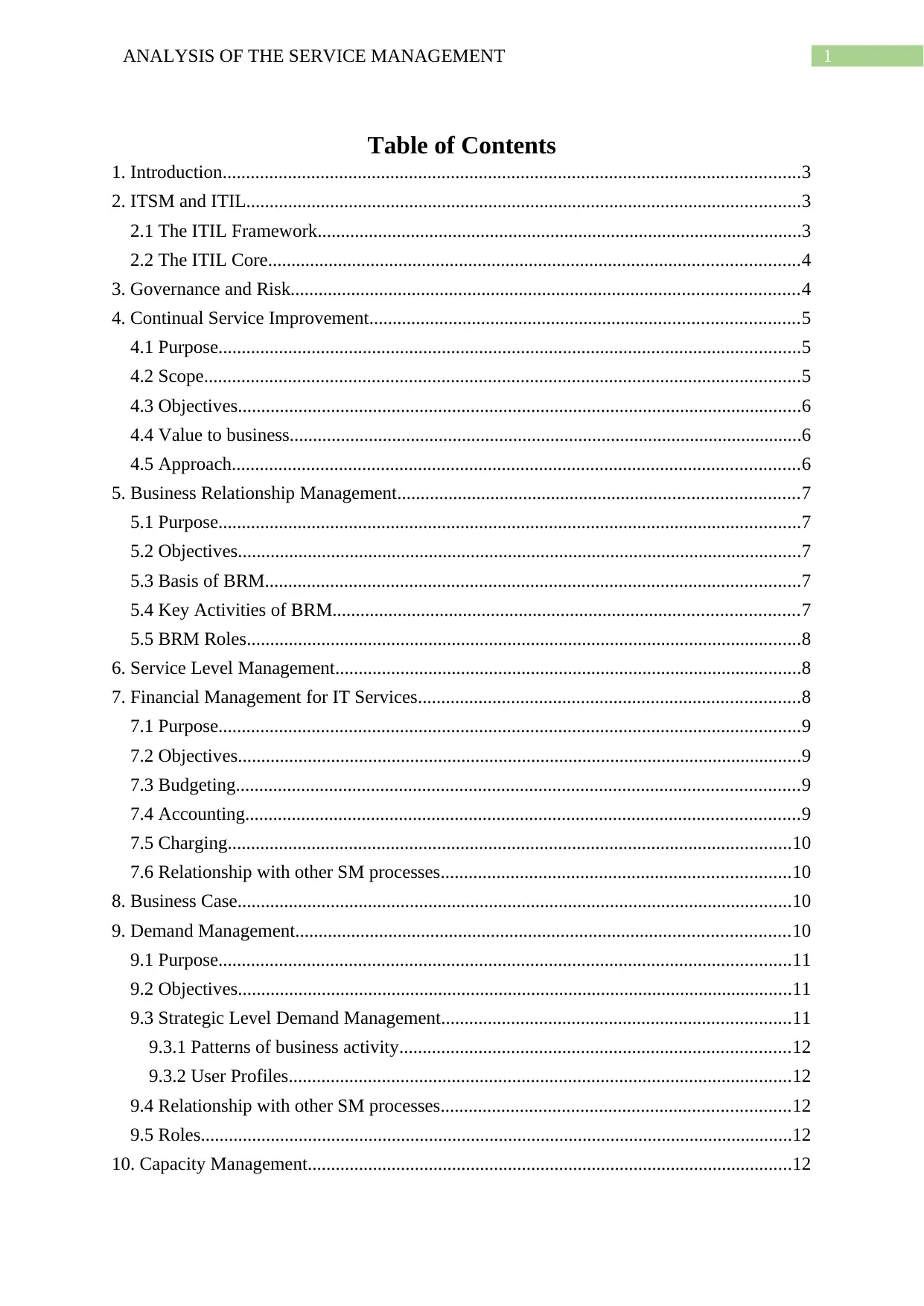
1ANALYSIS OF THE SERVICE MANAGEMENT
Table of Contents
1. Introduction............................................................................................................................3
2. ITSM and ITIL.......................................................................................................................3
2.1 The ITIL Framework........................................................................................................3
2.2 The ITIL Core..................................................................................................................4
3. Governance and Risk.............................................................................................................4
4. Continual Service Improvement............................................................................................5
4.1 Purpose.............................................................................................................................5
4.2 Scope................................................................................................................................5
4.3 Objectives.........................................................................................................................6
4.4 Value to business..............................................................................................................6
4.5 Approach..........................................................................................................................6
5. Business Relationship Management......................................................................................7
5.1 Purpose.............................................................................................................................7
5.2 Objectives.........................................................................................................................7
5.3 Basis of BRM...................................................................................................................7
5.4 Key Activities of BRM....................................................................................................7
5.5 BRM Roles.......................................................................................................................8
6. Service Level Management....................................................................................................8
7. Financial Management for IT Services..................................................................................8
7.1 Purpose.............................................................................................................................9
7.2 Objectives.........................................................................................................................9
7.3 Budgeting.........................................................................................................................9
7.4 Accounting.......................................................................................................................9
7.5 Charging.........................................................................................................................10
7.6 Relationship with other SM processes...........................................................................10
8. Business Case.......................................................................................................................10
9. Demand Management..........................................................................................................10
9.1 Purpose...........................................................................................................................11
9.2 Objectives.......................................................................................................................11
9.3 Strategic Level Demand Management...........................................................................11
9.3.1 Patterns of business activity....................................................................................12
9.3.2 User Profiles............................................................................................................12
9.4 Relationship with other SM processes...........................................................................12
9.5 Roles...............................................................................................................................12
10. Capacity Management........................................................................................................12
Table of Contents
1. Introduction............................................................................................................................3
2. ITSM and ITIL.......................................................................................................................3
2.1 The ITIL Framework........................................................................................................3
2.2 The ITIL Core..................................................................................................................4
3. Governance and Risk.............................................................................................................4
4. Continual Service Improvement............................................................................................5
4.1 Purpose.............................................................................................................................5
4.2 Scope................................................................................................................................5
4.3 Objectives.........................................................................................................................6
4.4 Value to business..............................................................................................................6
4.5 Approach..........................................................................................................................6
5. Business Relationship Management......................................................................................7
5.1 Purpose.............................................................................................................................7
5.2 Objectives.........................................................................................................................7
5.3 Basis of BRM...................................................................................................................7
5.4 Key Activities of BRM....................................................................................................7
5.5 BRM Roles.......................................................................................................................8
6. Service Level Management....................................................................................................8
7. Financial Management for IT Services..................................................................................8
7.1 Purpose.............................................................................................................................9
7.2 Objectives.........................................................................................................................9
7.3 Budgeting.........................................................................................................................9
7.4 Accounting.......................................................................................................................9
7.5 Charging.........................................................................................................................10
7.6 Relationship with other SM processes...........................................................................10
8. Business Case.......................................................................................................................10
9. Demand Management..........................................................................................................10
9.1 Purpose...........................................................................................................................11
9.2 Objectives.......................................................................................................................11
9.3 Strategic Level Demand Management...........................................................................11
9.3.1 Patterns of business activity....................................................................................12
9.3.2 User Profiles............................................................................................................12
9.4 Relationship with other SM processes...........................................................................12
9.5 Roles...............................................................................................................................12
10. Capacity Management........................................................................................................12
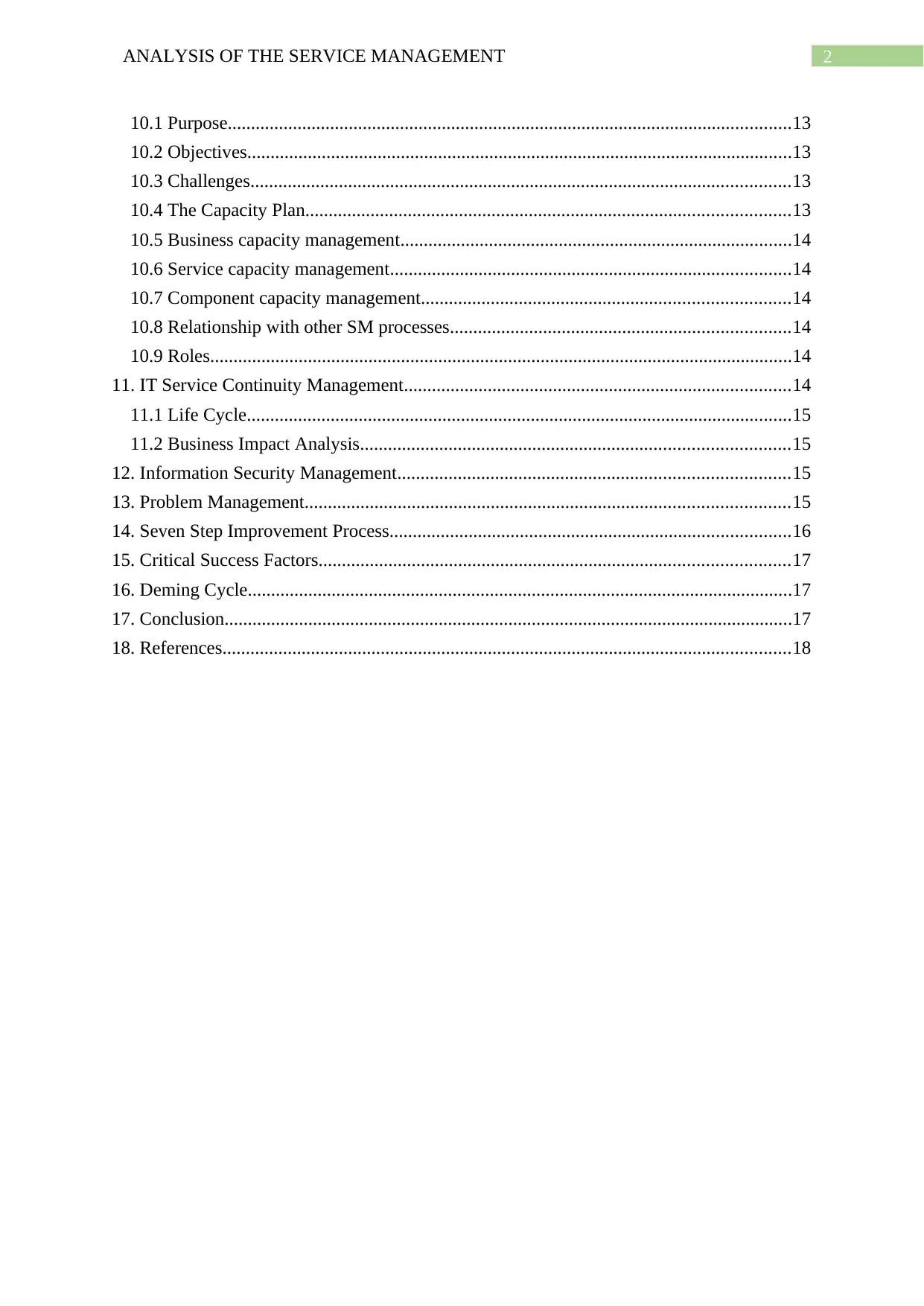
2ANALYSIS OF THE SERVICE MANAGEMENT
10.1 Purpose.........................................................................................................................13
10.2 Objectives.....................................................................................................................13
10.3 Challenges....................................................................................................................13
10.4 The Capacity Plan........................................................................................................13
10.5 Business capacity management....................................................................................14
10.6 Service capacity management......................................................................................14
10.7 Component capacity management...............................................................................14
10.8 Relationship with other SM processes.........................................................................14
10.9 Roles.............................................................................................................................14
11. IT Service Continuity Management...................................................................................14
11.1 Life Cycle.....................................................................................................................15
11.2 Business Impact Analysis............................................................................................15
12. Information Security Management....................................................................................15
13. Problem Management........................................................................................................15
14. Seven Step Improvement Process......................................................................................16
15. Critical Success Factors.....................................................................................................17
16. Deming Cycle.....................................................................................................................17
17. Conclusion..........................................................................................................................17
18. References..........................................................................................................................18
10.1 Purpose.........................................................................................................................13
10.2 Objectives.....................................................................................................................13
10.3 Challenges....................................................................................................................13
10.4 The Capacity Plan........................................................................................................13
10.5 Business capacity management....................................................................................14
10.6 Service capacity management......................................................................................14
10.7 Component capacity management...............................................................................14
10.8 Relationship with other SM processes.........................................................................14
10.9 Roles.............................................................................................................................14
11. IT Service Continuity Management...................................................................................14
11.1 Life Cycle.....................................................................................................................15
11.2 Business Impact Analysis............................................................................................15
12. Information Security Management....................................................................................15
13. Problem Management........................................................................................................15
14. Seven Step Improvement Process......................................................................................16
15. Critical Success Factors.....................................................................................................17
16. Deming Cycle.....................................................................................................................17
17. Conclusion..........................................................................................................................17
18. References..........................................................................................................................18
⊘ This is a preview!⊘
Do you want full access?
Subscribe today to unlock all pages.

Trusted by 1+ million students worldwide
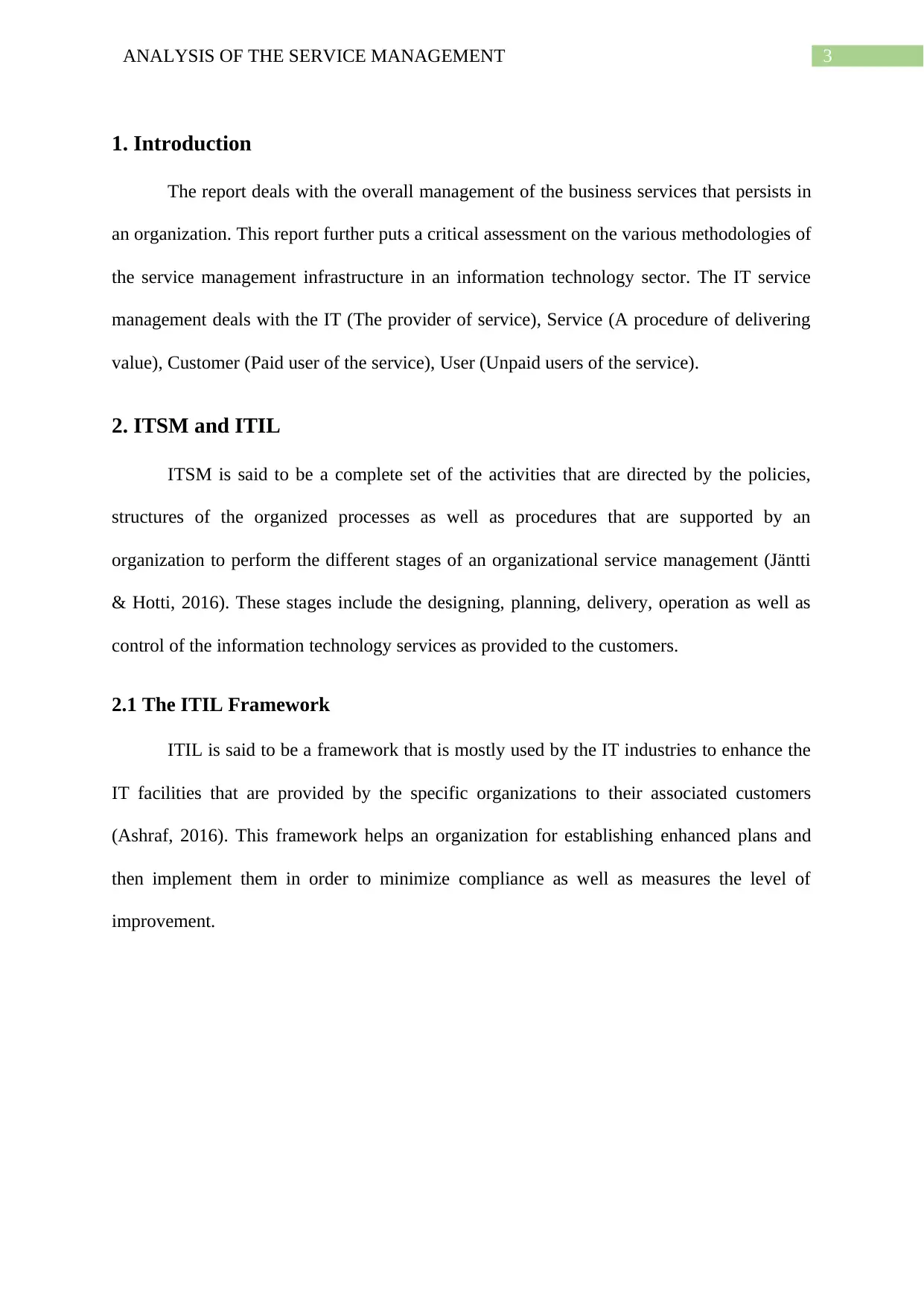
3ANALYSIS OF THE SERVICE MANAGEMENT
1. Introduction
The report deals with the overall management of the business services that persists in
an organization. This report further puts a critical assessment on the various methodologies of
the service management infrastructure in an information technology sector. The IT service
management deals with the IT (The provider of service), Service (A procedure of delivering
value), Customer (Paid user of the service), User (Unpaid users of the service).
2. ITSM and ITIL
ITSM is said to be a complete set of the activities that are directed by the policies,
structures of the organized processes as well as procedures that are supported by an
organization to perform the different stages of an organizational service management (Jäntti
& Hotti, 2016). These stages include the designing, planning, delivery, operation as well as
control of the information technology services as provided to the customers.
2.1 The ITIL Framework
ITIL is said to be a framework that is mostly used by the IT industries to enhance the
IT facilities that are provided by the specific organizations to their associated customers
(Ashraf, 2016). This framework helps an organization for establishing enhanced plans and
then implement them in order to minimize compliance as well as measures the level of
improvement.
1. Introduction
The report deals with the overall management of the business services that persists in
an organization. This report further puts a critical assessment on the various methodologies of
the service management infrastructure in an information technology sector. The IT service
management deals with the IT (The provider of service), Service (A procedure of delivering
value), Customer (Paid user of the service), User (Unpaid users of the service).
2. ITSM and ITIL
ITSM is said to be a complete set of the activities that are directed by the policies,
structures of the organized processes as well as procedures that are supported by an
organization to perform the different stages of an organizational service management (Jäntti
& Hotti, 2016). These stages include the designing, planning, delivery, operation as well as
control of the information technology services as provided to the customers.
2.1 The ITIL Framework
ITIL is said to be a framework that is mostly used by the IT industries to enhance the
IT facilities that are provided by the specific organizations to their associated customers
(Ashraf, 2016). This framework helps an organization for establishing enhanced plans and
then implement them in order to minimize compliance as well as measures the level of
improvement.
Paraphrase This Document
Need a fresh take? Get an instant paraphrase of this document with our AI Paraphraser
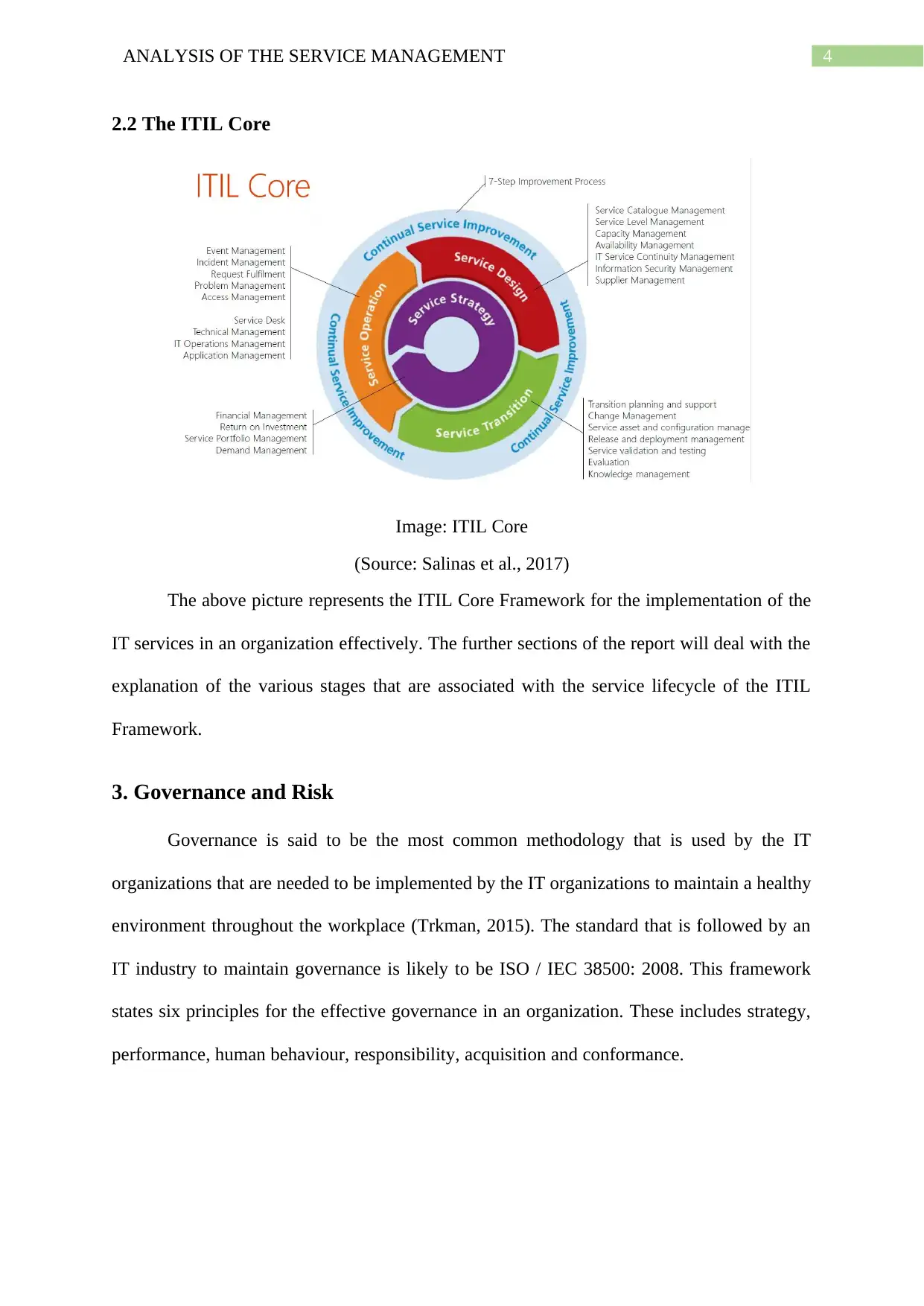
4ANALYSIS OF THE SERVICE MANAGEMENT
2.2 The ITIL Core
Image: ITIL Core
(Source: Salinas et al., 2017)
The above picture represents the ITIL Core Framework for the implementation of the
IT services in an organization effectively. The further sections of the report will deal with the
explanation of the various stages that are associated with the service lifecycle of the ITIL
Framework.
3. Governance and Risk
Governance is said to be the most common methodology that is used by the IT
organizations that are needed to be implemented by the IT organizations to maintain a healthy
environment throughout the workplace (Trkman, 2015). The standard that is followed by an
IT industry to maintain governance is likely to be ISO / IEC 38500: 2008. This framework
states six principles for the effective governance in an organization. These includes strategy,
performance, human behaviour, responsibility, acquisition and conformance.
2.2 The ITIL Core
Image: ITIL Core
(Source: Salinas et al., 2017)
The above picture represents the ITIL Core Framework for the implementation of the
IT services in an organization effectively. The further sections of the report will deal with the
explanation of the various stages that are associated with the service lifecycle of the ITIL
Framework.
3. Governance and Risk
Governance is said to be the most common methodology that is used by the IT
organizations that are needed to be implemented by the IT organizations to maintain a healthy
environment throughout the workplace (Trkman, 2015). The standard that is followed by an
IT industry to maintain governance is likely to be ISO / IEC 38500: 2008. This framework
states six principles for the effective governance in an organization. These includes strategy,
performance, human behaviour, responsibility, acquisition and conformance.

5ANALYSIS OF THE SERVICE MANAGEMENT
Risk may be defined as the incident that could mainly create a loss in the capability of
achieving objectives. Hence, the proper governance can carry out an effective management of
the risk in an ITIL Framework.
4. Continual Service Improvement
This process is mainly responsible regarding the improvements in the management of
the IT services as well as ITSM processes. The CSI mainly measures the performance of the
services that are provided by the IT industries and henceforth makes the necessary
improvements in the environment of the IT processes for the enhancement as well as
effective providing of services (Faniyi & Bahsoon, 2016).
Image: CSI for ITIL
(Source: Adam, 2017)
4.1 Purpose
The main purpose of CSI is to deliver the value of businesses, thus assuring the
implementation of the management of services for handling the desired benefits of the
business.
Risk may be defined as the incident that could mainly create a loss in the capability of
achieving objectives. Hence, the proper governance can carry out an effective management of
the risk in an ITIL Framework.
4. Continual Service Improvement
This process is mainly responsible regarding the improvements in the management of
the IT services as well as ITSM processes. The CSI mainly measures the performance of the
services that are provided by the IT industries and henceforth makes the necessary
improvements in the environment of the IT processes for the enhancement as well as
effective providing of services (Faniyi & Bahsoon, 2016).
Image: CSI for ITIL
(Source: Adam, 2017)
4.1 Purpose
The main purpose of CSI is to deliver the value of businesses, thus assuring the
implementation of the management of services for handling the desired benefits of the
business.
⊘ This is a preview!⊘
Do you want full access?
Subscribe today to unlock all pages.

Trusted by 1+ million students worldwide
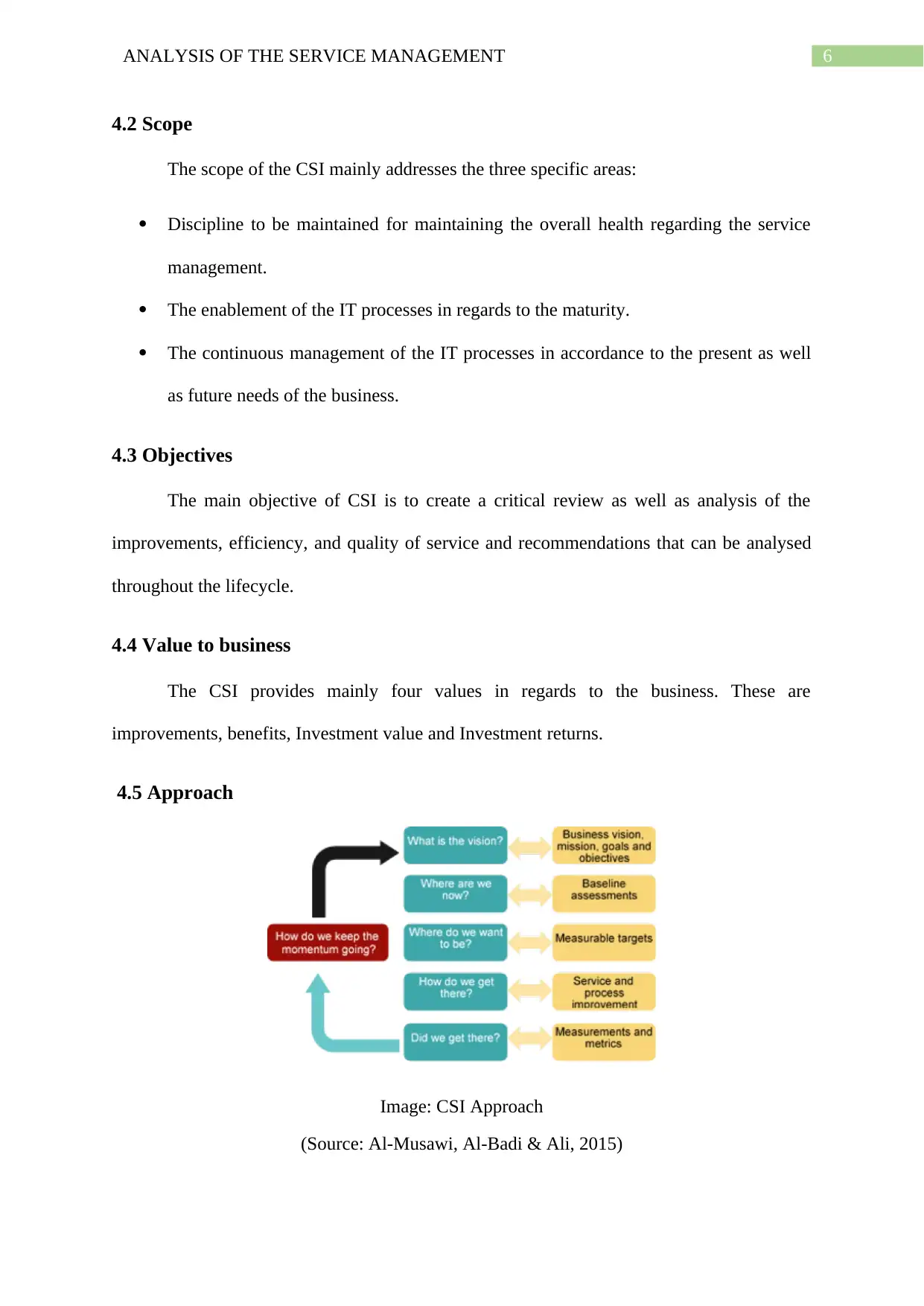
6ANALYSIS OF THE SERVICE MANAGEMENT
4.2 Scope
The scope of the CSI mainly addresses the three specific areas:
Discipline to be maintained for maintaining the overall health regarding the service
management.
The enablement of the IT processes in regards to the maturity.
The continuous management of the IT processes in accordance to the present as well
as future needs of the business.
4.3 Objectives
The main objective of CSI is to create a critical review as well as analysis of the
improvements, efficiency, and quality of service and recommendations that can be analysed
throughout the lifecycle.
4.4 Value to business
The CSI provides mainly four values in regards to the business. These are
improvements, benefits, Investment value and Investment returns.
4.5 Approach
Image: CSI Approach
(Source: Al-Musawi, Al-Badi & Ali, 2015)
4.2 Scope
The scope of the CSI mainly addresses the three specific areas:
Discipline to be maintained for maintaining the overall health regarding the service
management.
The enablement of the IT processes in regards to the maturity.
The continuous management of the IT processes in accordance to the present as well
as future needs of the business.
4.3 Objectives
The main objective of CSI is to create a critical review as well as analysis of the
improvements, efficiency, and quality of service and recommendations that can be analysed
throughout the lifecycle.
4.4 Value to business
The CSI provides mainly four values in regards to the business. These are
improvements, benefits, Investment value and Investment returns.
4.5 Approach
Image: CSI Approach
(Source: Al-Musawi, Al-Badi & Ali, 2015)
Paraphrase This Document
Need a fresh take? Get an instant paraphrase of this document with our AI Paraphraser

7ANALYSIS OF THE SERVICE MANAGEMENT
The approach of the CSI assesses the present situation regarding the vision
clarification, the IT visions within the organization, the goals as well as the objectives, which
will assure the overall understanding of the IT processes in the organization.
5. Business Relationship Management
The BRM is said to be a part of Service Strategy, which enables the relationship
managers to build a link between the customers as well as the service providers of the IT
industry. This methodology aims to maintain an effective relationship of the organization
with its customers (Mahalle, Yong & Tao, 2019). The BRM for ITIL Framework is identified
as the preferences of the customers associated with the organization for developing and
providing services for coping with the needs of the customers.
5.1 Purpose
The main purpose of the BRM is to develop as well as maintain the effective as well
as productive bonding among the IT service provider as well as the customers associated with
the organization.
5.2 Objectives
The objective of BRM is to understand the constant change in the needs as well as the
priorities of the customers so that the organization can efficiently provide response and cope
with the needs of the end users.
5.3 Basis of BRM
The BRM deployment is said to be an argument or understanding between a customer
as well as the IT service provider regarding the needs of the customer that seeks to meet up
the needs as well as improvements as requested by the customers.
The approach of the CSI assesses the present situation regarding the vision
clarification, the IT visions within the organization, the goals as well as the objectives, which
will assure the overall understanding of the IT processes in the organization.
5. Business Relationship Management
The BRM is said to be a part of Service Strategy, which enables the relationship
managers to build a link between the customers as well as the service providers of the IT
industry. This methodology aims to maintain an effective relationship of the organization
with its customers (Mahalle, Yong & Tao, 2019). The BRM for ITIL Framework is identified
as the preferences of the customers associated with the organization for developing and
providing services for coping with the needs of the customers.
5.1 Purpose
The main purpose of the BRM is to develop as well as maintain the effective as well
as productive bonding among the IT service provider as well as the customers associated with
the organization.
5.2 Objectives
The objective of BRM is to understand the constant change in the needs as well as the
priorities of the customers so that the organization can efficiently provide response and cope
with the needs of the end users.
5.3 Basis of BRM
The BRM deployment is said to be an argument or understanding between a customer
as well as the IT service provider regarding the needs of the customer that seeks to meet up
the needs as well as improvements as requested by the customers.

8ANALYSIS OF THE SERVICE MANAGEMENT
5.4 Key Activities of BRM
The key activities regarding the BRM is said to be the customer understandings with
the correlation of the business objectives that in turn to meet the necessary requirements of
the service. This also encourages the new service requirements that will be formulated for the
enhancement of the present services.
5.5 BRM Roles
The prime roles that are associated with the BRM are likely to be the owner and the
manager of the business relationship procedure.
6. Service Level Management
The BRM as well as SLM deals with the relationships that are long-term thus
ensuring the satisfaction of the customers (Elephant, 2019). The aim of this management is to
negotiate the service level agreements in association with the customers for designing the
services to cope with the needs of the customers that agrees on the provided service level
agreements.
Image: SLM
(Source: Yazici, Mishra & Kontogiorgis, 2015)
5.4 Key Activities of BRM
The key activities regarding the BRM is said to be the customer understandings with
the correlation of the business objectives that in turn to meet the necessary requirements of
the service. This also encourages the new service requirements that will be formulated for the
enhancement of the present services.
5.5 BRM Roles
The prime roles that are associated with the BRM are likely to be the owner and the
manager of the business relationship procedure.
6. Service Level Management
The BRM as well as SLM deals with the relationships that are long-term thus
ensuring the satisfaction of the customers (Elephant, 2019). The aim of this management is to
negotiate the service level agreements in association with the customers for designing the
services to cope with the needs of the customers that agrees on the provided service level
agreements.
Image: SLM
(Source: Yazici, Mishra & Kontogiorgis, 2015)
⊘ This is a preview!⊘
Do you want full access?
Subscribe today to unlock all pages.

Trusted by 1+ million students worldwide
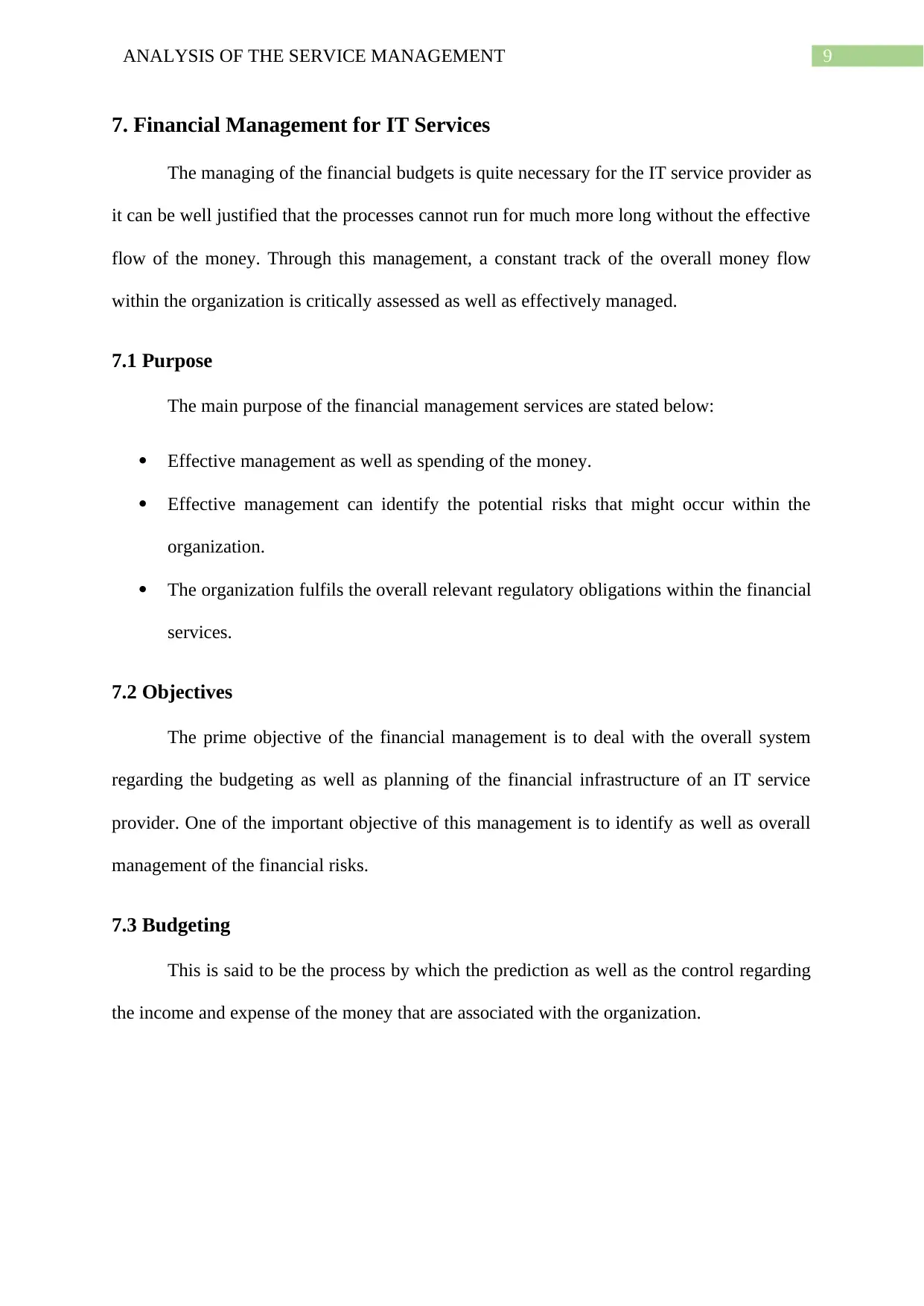
9ANALYSIS OF THE SERVICE MANAGEMENT
7. Financial Management for IT Services
The managing of the financial budgets is quite necessary for the IT service provider as
it can be well justified that the processes cannot run for much more long without the effective
flow of the money. Through this management, a constant track of the overall money flow
within the organization is critically assessed as well as effectively managed.
7.1 Purpose
The main purpose of the financial management services are stated below:
Effective management as well as spending of the money.
Effective management can identify the potential risks that might occur within the
organization.
The organization fulfils the overall relevant regulatory obligations within the financial
services.
7.2 Objectives
The prime objective of the financial management is to deal with the overall system
regarding the budgeting as well as planning of the financial infrastructure of an IT service
provider. One of the important objective of this management is to identify as well as overall
management of the financial risks.
7.3 Budgeting
This is said to be the process by which the prediction as well as the control regarding
the income and expense of the money that are associated with the organization.
7. Financial Management for IT Services
The managing of the financial budgets is quite necessary for the IT service provider as
it can be well justified that the processes cannot run for much more long without the effective
flow of the money. Through this management, a constant track of the overall money flow
within the organization is critically assessed as well as effectively managed.
7.1 Purpose
The main purpose of the financial management services are stated below:
Effective management as well as spending of the money.
Effective management can identify the potential risks that might occur within the
organization.
The organization fulfils the overall relevant regulatory obligations within the financial
services.
7.2 Objectives
The prime objective of the financial management is to deal with the overall system
regarding the budgeting as well as planning of the financial infrastructure of an IT service
provider. One of the important objective of this management is to identify as well as overall
management of the financial risks.
7.3 Budgeting
This is said to be the process by which the prediction as well as the control regarding
the income and expense of the money that are associated with the organization.
Paraphrase This Document
Need a fresh take? Get an instant paraphrase of this document with our AI Paraphraser
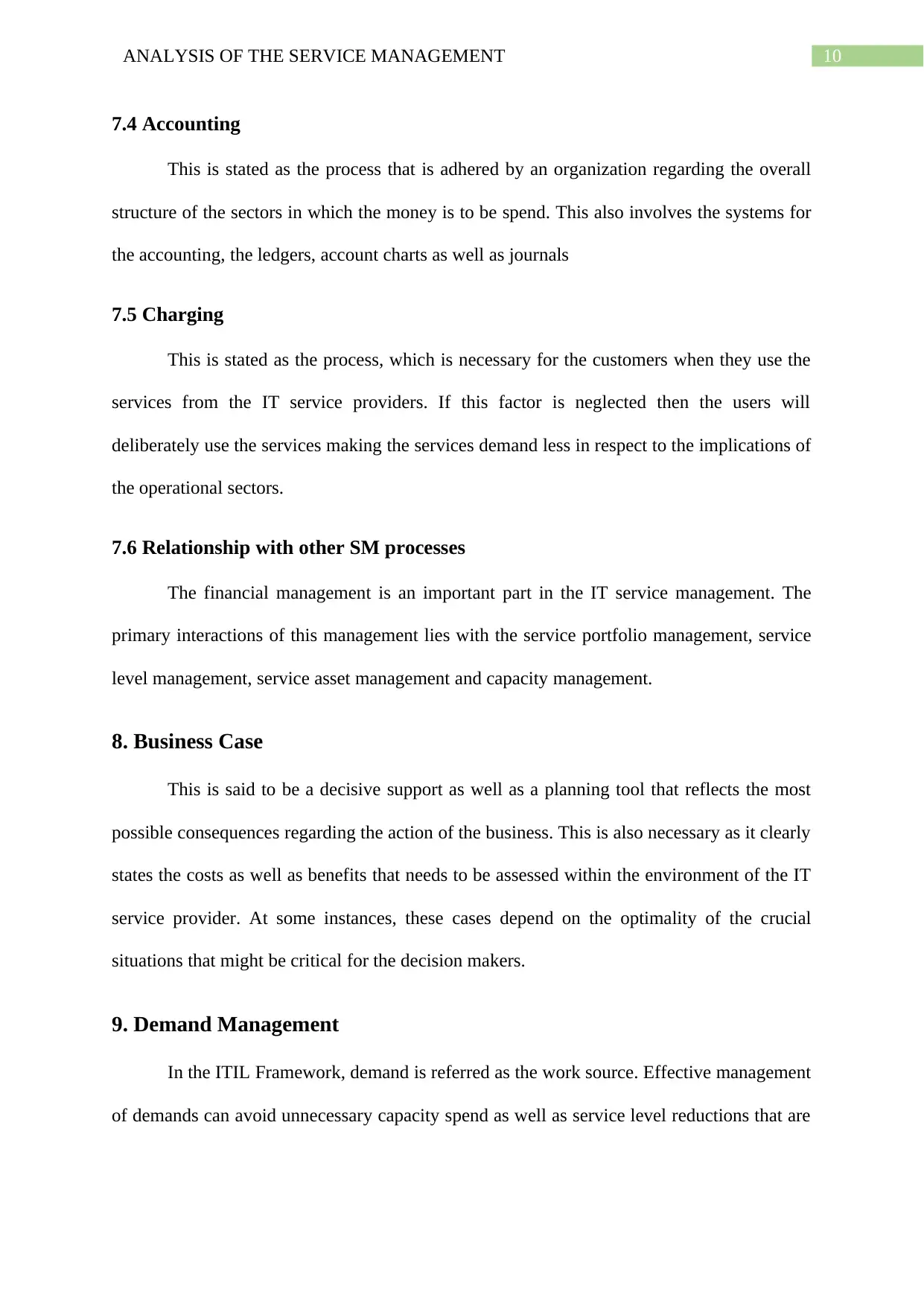
10ANALYSIS OF THE SERVICE MANAGEMENT
7.4 Accounting
This is stated as the process that is adhered by an organization regarding the overall
structure of the sectors in which the money is to be spend. This also involves the systems for
the accounting, the ledgers, account charts as well as journals
7.5 Charging
This is stated as the process, which is necessary for the customers when they use the
services from the IT service providers. If this factor is neglected then the users will
deliberately use the services making the services demand less in respect to the implications of
the operational sectors.
7.6 Relationship with other SM processes
The financial management is an important part in the IT service management. The
primary interactions of this management lies with the service portfolio management, service
level management, service asset management and capacity management.
8. Business Case
This is said to be a decisive support as well as a planning tool that reflects the most
possible consequences regarding the action of the business. This is also necessary as it clearly
states the costs as well as benefits that needs to be assessed within the environment of the IT
service provider. At some instances, these cases depend on the optimality of the crucial
situations that might be critical for the decision makers.
9. Demand Management
In the ITIL Framework, demand is referred as the work source. Effective management
of demands can avoid unnecessary capacity spend as well as service level reductions that are
7.4 Accounting
This is stated as the process that is adhered by an organization regarding the overall
structure of the sectors in which the money is to be spend. This also involves the systems for
the accounting, the ledgers, account charts as well as journals
7.5 Charging
This is stated as the process, which is necessary for the customers when they use the
services from the IT service providers. If this factor is neglected then the users will
deliberately use the services making the services demand less in respect to the implications of
the operational sectors.
7.6 Relationship with other SM processes
The financial management is an important part in the IT service management. The
primary interactions of this management lies with the service portfolio management, service
level management, service asset management and capacity management.
8. Business Case
This is said to be a decisive support as well as a planning tool that reflects the most
possible consequences regarding the action of the business. This is also necessary as it clearly
states the costs as well as benefits that needs to be assessed within the environment of the IT
service provider. At some instances, these cases depend on the optimality of the crucial
situations that might be critical for the decision makers.
9. Demand Management
In the ITIL Framework, demand is referred as the work source. Effective management
of demands can avoid unnecessary capacity spend as well as service level reductions that are
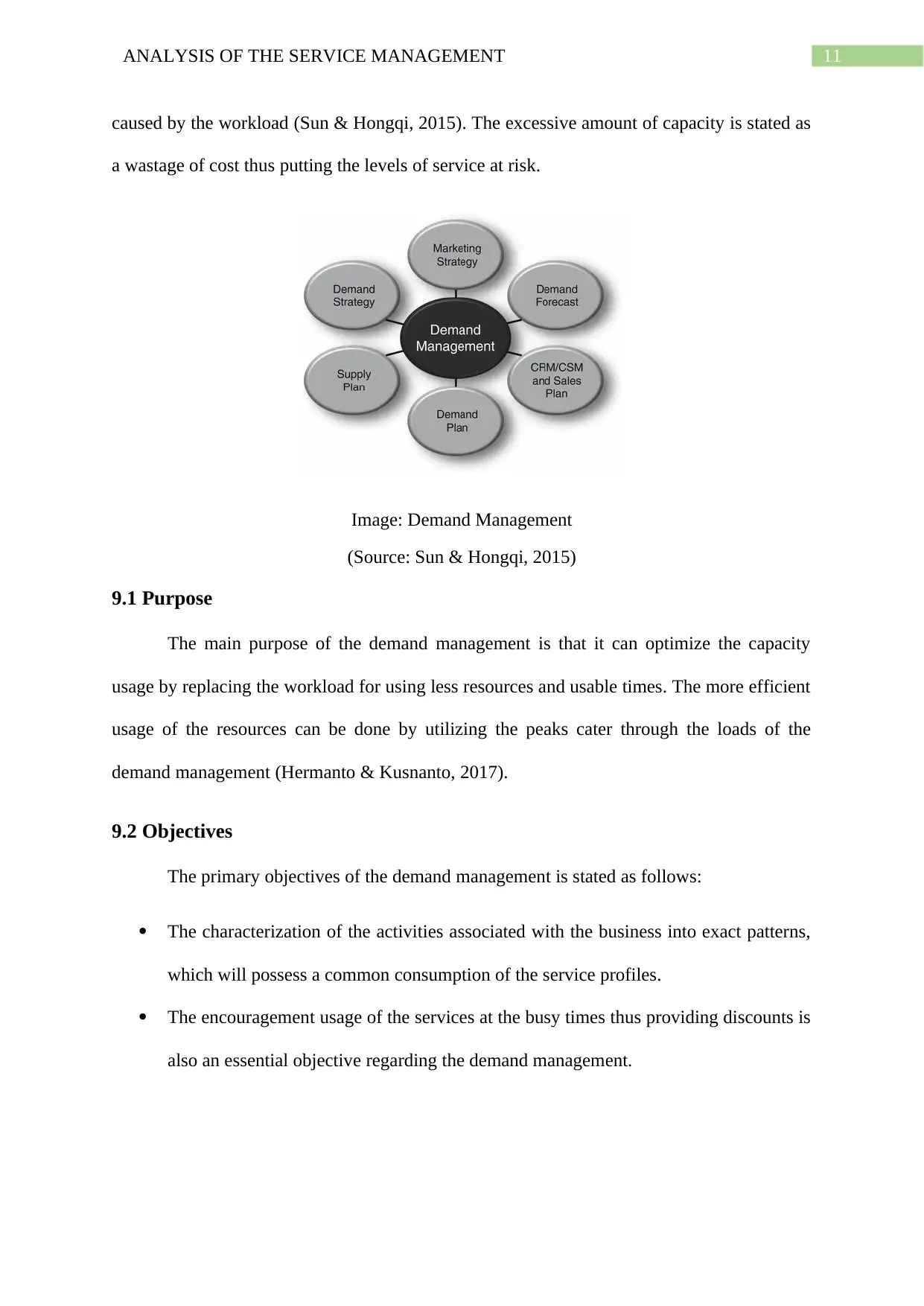
11ANALYSIS OF THE SERVICE MANAGEMENT
caused by the workload (Sun & Hongqi, 2015). The excessive amount of capacity is stated as
a wastage of cost thus putting the levels of service at risk.
Image: Demand Management
(Source: Sun & Hongqi, 2015)
9.1 Purpose
The main purpose of the demand management is that it can optimize the capacity
usage by replacing the workload for using less resources and usable times. The more efficient
usage of the resources can be done by utilizing the peaks cater through the loads of the
demand management (Hermanto & Kusnanto, 2017).
9.2 Objectives
The primary objectives of the demand management is stated as follows:
The characterization of the activities associated with the business into exact patterns,
which will possess a common consumption of the service profiles.
The encouragement usage of the services at the busy times thus providing discounts is
also an essential objective regarding the demand management.
caused by the workload (Sun & Hongqi, 2015). The excessive amount of capacity is stated as
a wastage of cost thus putting the levels of service at risk.
Image: Demand Management
(Source: Sun & Hongqi, 2015)
9.1 Purpose
The main purpose of the demand management is that it can optimize the capacity
usage by replacing the workload for using less resources and usable times. The more efficient
usage of the resources can be done by utilizing the peaks cater through the loads of the
demand management (Hermanto & Kusnanto, 2017).
9.2 Objectives
The primary objectives of the demand management is stated as follows:
The characterization of the activities associated with the business into exact patterns,
which will possess a common consumption of the service profiles.
The encouragement usage of the services at the busy times thus providing discounts is
also an essential objective regarding the demand management.
⊘ This is a preview!⊘
Do you want full access?
Subscribe today to unlock all pages.

Trusted by 1+ million students worldwide
1 out of 22
Related Documents
Your All-in-One AI-Powered Toolkit for Academic Success.
+13062052269
info@desklib.com
Available 24*7 on WhatsApp / Email
![[object Object]](/_next/static/media/star-bottom.7253800d.svg)
Unlock your academic potential
Copyright © 2020–2025 A2Z Services. All Rights Reserved. Developed and managed by ZUCOL.




